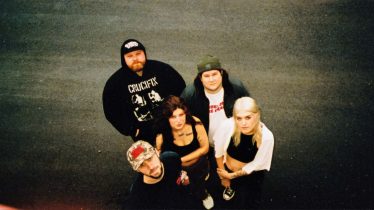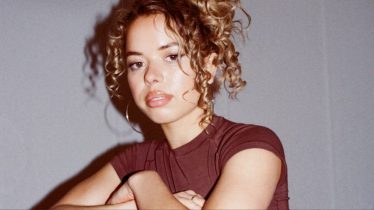
The oral history of Saddle Creek's fight upstream
Ever since the independent record label boom of the 1980s, hundreds of new indie labels have emerged from every corner of the world, each trying to make their mark. The mission is usually the same: turn people on to good music, help budding musicians break through, and maybe make a little money (though breaking even is usually more realistic). To achieve this kind of creative fulfillment, a dedicated team willing to sacrifice their free time and energy is practically required.
Thirty years ago, a group of friends and collaborators in Omaha, Nebraska, were going to do whatever it took to share their music and art with the world — even if that world existed entirely within the Omaha city limits.
Read more: 11 LGBTQIA+ and women-owned labels that are changing the music industry
Nowadays, Saddle Creek might seem like a star-maker within the independent music scene, launching bands and artists like Big Thief, Feeble Little Horses, and Indigo De Souza, but as with most things, its origin lies in the hard work of a dedicated few.

To celebrate Saddle Creek’s 30th birthday, Alternative Press caught up with some of the key players, looking back at the label's humble beginnings and how it has grown over the last three decades.
Origin Story: The Creek Runs Deep
Born in Omaha in 1993, Saddle Creek centered on a group of friends looking to bring their music to the world.
ROBB NANSEL (President and Owner of Saddle Creek): The label began in Omaha as more of a conceptual thing. It was just a bunch of friends of ours who were all fans of the music going on there at the time and wanted to form something that had commonality, camaraderie, that sort of thing.
ZACK NIPPER (Saddle Creek graphic designer/artist): Omaha was just this small town where we all knew each other. I was friends with people, and just got involved by just knowing all these guys. I met Conor [Oberst], for the first time when he was like 12 or something.
NANSEL: We were just high school friends playing in bands, then we started releasing tapes and 7” and stuff. A Conor Oberst solo cassette was the very first thing, followed by a band called Slowdown Virginia, which was a lot of the guys who went on to form Cursive. Mike Mogis and I were in this entrepreneurship class together and that’s when we decided to really make a go at the label and distribute nationally. Up until that point we were more of a consignment label, doing everything locally, and we went by the name Lumberjack Records. When we started distributing nationally we ran into a few people who were confused because there was already a Lumberjack distributor out there, so we changed it to Saddle Creek Records. Saddle Creek was this road that cut right through Omaha. Omaha is very much a grid and every street is very straight but Saddle Creek is the one street that kind of curves through midtown.
NIPPER: Early on, Saddle Creek was just putting stuff out to get it out there. Nobody was making any money. A lot of it was a breakeven proposition. When I got to know Conor better, around the time he was putting out Letting Off The Happiness, he asked me to do this silk screen design for the record jacket. I didn't charge him anything because nobody was making any kind of money.
NANSEL: At that point we didn’t have staff, so everything was falling on the few people that were there, which was Mike and I at the time.
NIPPER: When I was first doing stuff and bringing it to Robb he was working out of his apartment and doing pretty much all the jobs for the label.
NANSEL: I took a full-time position after graduating college doing graphic design work, so I was working from the break of dawn on Saddle Creek stuff and then working second shift there from 2 to 10. It became sort of unsustainable.
NIPPER: He is doing graphic design, accounting, A&R, mail order, everything. He’s got boxes of records and CDs piling up to the ceiling. He’s laying out print catalogs that go in the records. I saw him working, you know, 12 hour days, every day. Nobody else, at the time, wanted to do all of that work, because it didn't pay anything.
Following The Current
The team at Saddle Creek took example from some of their heroes and contemporaries when forming their fledgling label.
NANSEL: Superchunk was probably my favorite band at the time so I figured out how many records Superchunk has sold on their latest record and, somehow, 10,000 is the number I landed on. So that was kind of the “business plan.” I thought, if we can sell 10,000 records of something that would be insane. That’s the definition of success.
NIPPER: We all had labels that we loved and anybody else who were up around the time loved; Merge and Discord and you know, any of those other really seminal labels. Back in the day before the web, it was like, you know, you'd go to a record store and you see a release and you don't know anything about it, but it's on Discord or Merge, so you buy it.

NANSEL: We had different templates to work from that we grew up following. You know, like Discord, Merge, and Matador and different regional Indie labels like that. And so we kind of knew what that looked like, at least in terms of what an independent regional based kind of record label was.
NIPPER: I loved the fact that there was a story behind the label and that the bands are woven through the history of the label. You want to have some kind of personal connection to it.
NANSEL: There was also a label out of Lincoln, Nebraska, called Caulfield Records, which was run by this guy named Bernie McGann. He was sort of like an elder statesman in the scene who was a few years older than us, but he was super helpful. He taught us how to build a website, and how to reach out to AAM, which is this college Radio promoter. He showed us some of the ropes. That was something that I found was always super cool with the other record labels in the world. Everyone was always so helpful and generous with their time. I remember reaching out to Jonathan (Poneman), and people with Sub Pop, and they would take the calls and answer questions. It just seemed like a very supportive community.
The Creek Will Rise
Omaha bands like Cursive, Bright Eyes, and The Faint were instrumental in the label’s early success, but it wasn’t long till the label began to expand their scope.
NANSEL: I remember there was a very specific point where Magnet Magazine called my mom’s house, which was the phone number people would get at the time when they tried to track down Saddle Creek. She gave them my work line and they called me wanting to do this Bright Eyes profile. That was kind of the moment where I knew something had to give.
NIPPER: Conor had been making music since I met him, when he was releasing cassette tapes. Since he was so young I wasn’t really taking it all that seriously, but I knew other musicians who would talk about how talented he was. Then when he went to college and started to mature, I started to really realize how good he really was, especially in those early days when it was still pretty rough.
NANSEL: Bright Eyes, Cursive, and The Faint were the three core bands at the time. They all got brought up together. I was such a fan of all that stuff and it felt like someone needed to support it. The label was almost a by-product of no one wanting to sign our bands. Like, if no one wants to sign these bands then we’ll just do it ourselves.
NATE WELKER (Digital Operations and Marketing): In high school I was at this girl’s house and she was playing The Faint’s Danse Macabre. I had heard Bright Eyes but I don’t think I had yet heard Cursive. I knew about labels and recognized these bands were all on the same label but I think that’s the first time I grasped the fact that they were all part of this “scene,” you know? It’s the first time I recognized a kind of community and how important that all is.
NANSEL: There was one particular moment that seemed important. It was around the release of Cursive's The Storms Of Early Summer and Bright Eyes’ Letting Off The Happiness. I remember receiving the stock for those records in my mom’s basement and it was this weird moment where it was like, okay, how do we make this work? There wasn’t a ton of interest or demand but it was starting to percolate a little bit. When we put out Letting Off The Happiness and The Storms Of Early Summer we were really pushing against the stream and trying to get people to care. It was really the next series of Bright Eyes and Cursive record, Fevers And Mirrors and Domestica where there was actually anticipation, which was something we never had before. That felt like a seismic shift where we didn’t have to convince people anymore. That was kind of a big moment where I was like, alright, maybe this is sort of working.

NIPPER: There was this big shift in the label where it changed from ‘Which record from our friends are we putting out next?’ to trying to sign a band like Rilo Kiley. We became friends with them, but they didn’t grow up in Omaha and we didn’t put out the record because we were already friends with them.
NANSEL: That all happened as the bands started touring. They became the A&R for the label. They would go on the road, and they would play with bands in different cities and they'd come back home and be like, Oh, man, we met this band in Athens, Azure Ray and they are amazing and we should work with them!’ When bands started touring, we kind of started having more opportunities to work with bands outside of Omaha. And we did it as much as we could.
Welker: They were able to bring in these other artists and create this warm and nurturing thing. Look at the opening of Bright Eyes’ Lifted or The Story Is in the Soil, Keep Your Ear to the Ground and how it starts with Conor (Oberst) and Jenny Lewis talking in the car. I just thought it was so cool and so interesting. It felt like something you wanted to be a part of yourself.
NIPPER: It just kind of grew organically. And there were some pains along the way, because it wasn't all settled.
NANSEL: Obviously the label was still kind of getting going and we didn't have unlimited time, or hours or energy or resources, so there was only so much we could do.
NIPPER: There was a bit of friction because the original intention of the label — then Lumberjack Records — was literally just to put out music from friends. Then there were points where a friend's record wouldn’t get released or they didn’t get signed to Saddle Creek even though they were friends. There wasn’t a rulebook or mission statement per say; it was just people figuring it out as they went along.
A Creek Runs Through It
As the label continued to expand, Nansel and company added artists from all over the world, while still retaining a small-town sensibility.
NANSEL: I know in the early days some people wrote about the Saddle Creek sound, but I never really knew exactly what that meant. Bright Eyes doesn’t sound like Cursive and Cursive doesn’t sound like The Faint, and none of those things sound like Azure Ray.
NIPPER: The Faint is part of the sound because they were friends of ours. Nobody asked, ‘Does this sound like a Saddle Creek release?’ because it just was.
NANSEL: I guess the one thread amongst all those things is maybe just appreciation of songwriting. We all kind of grew up listening to Jackson Browne records and things like that, you know, so there's a root level of songwriting that I think all those guys kind of appreciated. And then it was just that The Faint chose to overlay that with different sounds than acoustic guitars and heavy electric guitars, you know, different people chose to accentuate it differently.
STEF CHURA (current Saddle Creek artist): I remember really hearing about Saddle Creek when Bright Eyes’ Cassedega came out. I had listened to Bright Eyes before but I wasn’t super aware of the label. I did a lot of driving around in my small hometown to that album and the self-titled Conor record that came out around the same time.
WELKER: It was never really a sound thing as much as it was kind of, you know, something that just kind of grew organically from from local to then expanded.

INDIGO DE SOUZA (current Saddle Creek artist): I was originally taken by Saddle Creek because their team is incredibly kind and considerate towards artists' mental health. That really stood out to me. I also really felt that they believed in me. Sometimes interest can feel empty, but theirs felt genuine and filled with curiosity.
CHURA: I really admired the musicians they were putting out at the time I started talking to them. I tend to lean towards music with female vocals and a lot of the women on the Saddle Creek roster are people that have unique voices that I resonate with.
NANSEL: I remember when we first started working with Hop Along, I remember that was pretty exciting. I feel like we'd been a little quiet going into that, and that felt really exciting. That kind of felt like a little bit of a rejuvenation point.
CHURA: Her voice really stops you and makes you go “who is that?
NANSEL: The conversation was changing. People wanted to talk about Big Thief and Hop Along and other stuff we were doing rather than Bright Eyes. The tone definitely shifted. We’ve been sort of sprinting since then and have had a bunch of new signings. The stuff with Indigo De Souza definitely sticks out and is super exciting and promising.
NIPPER: It's a good thing that you don't have rules about, well, this, this is part of our sound we're going for or, you know, or something like that because you'd miss out on stuff that's amazing.








